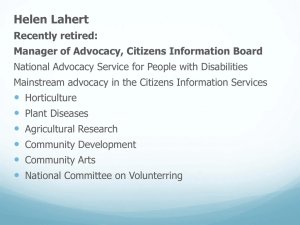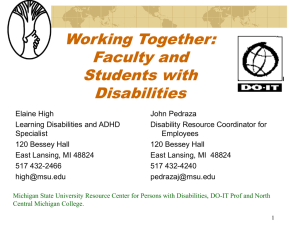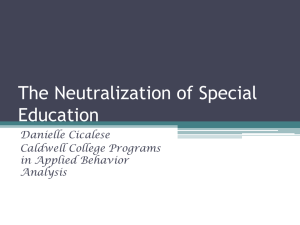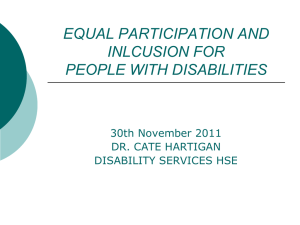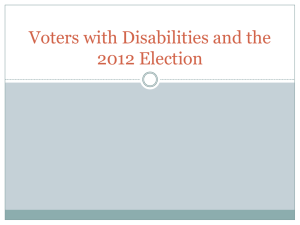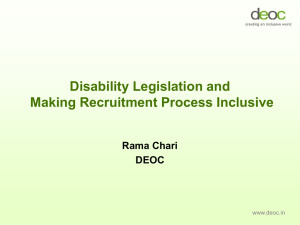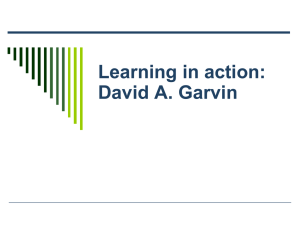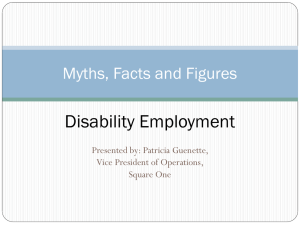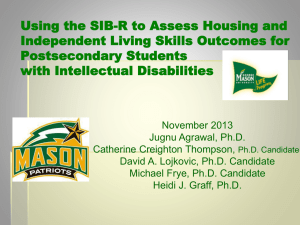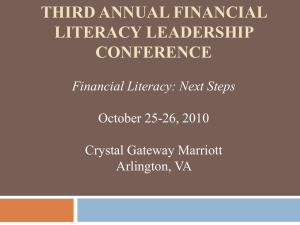Financial Education for Persons with Disabilities
advertisement
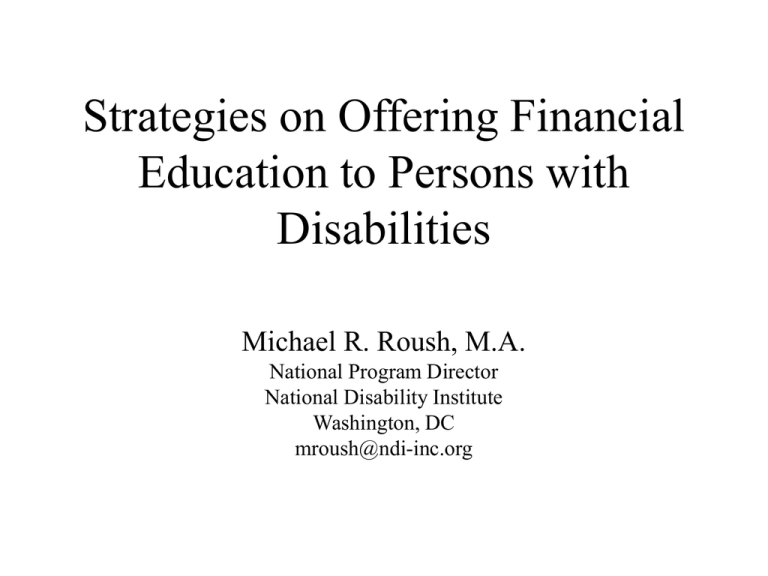
Strategies on Offering Financial Education to Persons with Disabilities Michael R. Roush, M.A. National Program Director National Disability Institute Washington, DC mroush@ndi-inc.org National Disability Institute A national research and development organization with the mission to promote income preservation and asset development for persons with disabilities and to build a better economic future for Americans with disabilities. The Americans with Disabilities Act of 1990 • The Nation’s proper goals regarding individuals with disabilities are to assure equality of opportunity, full participation, independent living, and economic selfsufficiency for such individuals; 42 U.S.C. § 1201(a)(8) (2005) Background Information • No group in America is more in need and more deserving of economic recovery • 58 million Americans with disabilities…1 in 5 (20% of the population) • 20 million families have at least one (1) member with a disability • Three times more likely than their peers without a disability to live at or below the poverty line • Dependence on public benefits for income, health care, food, and housing becomes a trap that requires staying poor to stay eligible • Complex public benefit system Financial Education & Persons with Disabilities • Little federal or private attention has been given to the study of financial education for persons with disabilities. • Financial education is understudied, un-funded and mainly unrecognized as a piece of the puzzle in reducing poverty and building economic independence and self-sufficiency for working adults with disabilities. • TaxFacts+ Campaign found that only 21 percent of 649 working individuals earning $35,000 or less had participated in a class or workshop on how to handle their money. • Participants reported teaching material used for financial education was not understandable or accessible. Financial Education for Persons with Disabilities • Need a framework for building financial relationships with non-traditional partners in the community. • Professionals in financial services need education about the specific needs of individuals with disabilities on public benefits who are working. • Employers of individuals with disabilities need information and guidance in assisting workers with various options for employee benefits. Tips for Providing Financial Education to Persons with Disabilities • Disability Etiquette & Use People First Language • Complex roadmap in navigating public benefit system – important to be mindful of this • Relevant topics to individuals ex. 401 K may not be as important due to resource limits • Be creative and make it interactive • Incorporate financial institutions and non-traditional partners in the delivery of the curriculum • Make materials accessible Disability Etiquette: Additional Resources • For Additional Information on Disability Etiquette please check out the following links: – “At Your Service: Welcoming Customers with Disabilities” – this self-paced web course was designed for front-line staff in a One-Stop Career Center however it has many general guidelines on serving people with may different disabilities http://www.wiawebcourse.org/ – Job Accommodation Network – This website has an abundance of resources and information about serving and accommodating people with disabilities. http://www.jan.wvu.edu/ People First Language • Positive language empowers. • When writing or speaking about people with disabilities, it is important to put the person first. • Group designations such as "the blind," "the retarded" or "the disabled" are inappropriate because they do not reflect the individuality, equality or dignity of people with disabilities. • Further, words like "normal person" imply that the person with a disability isn't normal, whereas "person without a disability" is descriptive but not negative. Making Materials Accessible & Providing Accommodations • Alternative Formats (examples) – Braille – Large print • Accommodations (examples) – American Sign Language Interpreters – Additional time for tests – Reading questions aloud • Technology (examples) – Screen readers – Closed captioning for videos Community Resources that Support Persons with Disabilities • • • • • • • • Center for Independent Living Goodwill Industries Rehabilitation Services Easter Seals One Stop Career Centers American Council of the Blind Developmental Disabilities Council Center for Autism and Related Disorders Resources and Tools • National Disability Institute www.realeconomicimpact.org • VISA Financial Soccer (REI Tour version) www.realeconomicimpact.org • FDICs Money Smart Curriculum www.fdic.org • Practical Money Skills for Life www.practicalmoneyskills.com/games • Doorways to Dreams ww.d2d.org • Job Accommodation Network www.askjan.org Best Practices • 30-second Financial Education Trainings • Building Economic Strength Together (BEST) 30-Second Financial Education Trainings • The purpose of the 30-Second Trainings is that they are designed to be short, easy and fun, they are not designed to be a test but rather to increase knowledge of financial education, they should only take about 30 seconds to review and that they Include national, reputable resources for follow up information. Building Economic Strength Together (B.E.S.T.) Program • To convene groups of citizens with and without disabilities for the purpose of increasing their economic self sufficiency. • Customized a six part financial and asset building curriculum for three target audiences; Students with intellectual disabilities; veterans with disabilities and the employment provider network. • Adopted study circle model that promotes interactive and participatory learning and invites experts in the community to deliver content subjects. The Arc Jacksonville On Campus Transition at UNF NDI BEST Jacksonville Project Graduates Questions

